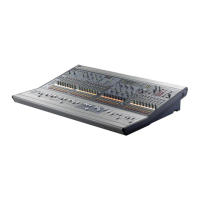D-Show Profile Guide88
3 In the Input Encoder Assignment section, press a Send
switch to assign control of the designated bus to the rotary en-
coders.
• The first press of an Aux Send switch assigns level control
of the odd-numbered send. The switch lights green to in-
dicate an odd-numbered selection.
• The second press of an Aux Send switch assigns level con-
trol of the even-numbered send. The switch lights yellow
to indicate an even-numbered selection.
4 On each of the channels you want to send to the designated
Aux bus or Variable Group bus, press the rotary encoder knob
so that its “On” indicator LED lights.
5 Turn the rotary encoder knob on each channel to set the
Aux Send or Variable Group Send level.
When Aux busses or Variable Group busses are not linked,
they are fed as true mono busses. In this configuration, input
signals are handled as follows:
Mono Input Signals Contributing mono signals are sent to the
mono Aux or Variable Group bus. Any pan information from
mono input channels feeding the bus is ignored.
Stereo Input Signals Contributing stereo signals are summed
to the mono Aux or Variable Group bus. The balance and
width information from each stereo input channel is ignored.
Routing Signals to Linked Aux and Variable
Group Bus Pairs
To route channels to a linked (stereo) Aux bus pair or Variable
Group bus pair from the Input section:
1 Do one of the following to select input channels:
• Target the channel you want to send to an Aux bus by
pressing its Select switch.
– or –
• Hold the Multi Select switch, then press the Select
switches on each of the channels you want to send to an
Aux bus.
2 Do one of the following:
• Press an Encoder assign Send switch 1–2 through 15–16
to display Aux Sends on the input channels.
• Press the Var Groups switch in the ACS Bus Assigns sec-
tion. This displays Variable Group Sends on the input
channel encoders and the ACS Aux Send controls.
3 In the Input Encoder Assignment section, press a Send
switch to assign control of the designated bus to the rotary en-
coders.
• The first press of an Aux switch assigns level control of
the linked sends.
• The second press assigns pan control of the linked sends.
The switch lights yellow to indicate pan control.
4 On each of the channels you want to send to the designated
bus pair, press the rotary encoder knob so that its “On” indi-
cator LED lights.
5 Turn the rotary encoder knob on each channel to set the
send level or pan.
When Aux busses are linked, input signals are handled as fol-
lows:
Mono Input Signals Contributing mono signals are panned
across the linked odd/even Aux or Variable Group bus pair.
• When the Follows Channels Pan option is off, panning
of the mono signal to the bus pair is controlled by the
Aux Pan control (the even-numbered send).
• When the Follows Channels Pan option is on, the pan in-
formation from each mono input channel determines its
pan position in the bus pair.
Stereo Input Signals Contributing stereo signals are panned
across the linked odd/even Aux or Variable Group bus pair.
Stereo width information from the input channel is applied to
the bus signal.
• When the Follows Channels Pan option is off, balance of
the stereo signal to the bus pair is controlled by the Aux
Pan control.
• When the Follows Channels Pan option is on, the bal-
ance from each stereo input channel determines its con-
tribution to the odd and even sides of the bus pair.
Routing Aux and Variable Group
Busses to Outputs and Plug-Ins
Aux and Variable Group busses can be routed to hardware out-
puts, and to available bus-fed plug-ins. Aux and Variable Aux
and Variable Group busses also provide Direct Outs, inserts
and built-in Graphic EQ capabilities.
Routing Aux and Variable Group Busses to Direct Outputs See
“Direct Outputs” on page 76.
Using Inserts on Aux and Variable Group Busses See “Using In-
serts on Output Busses” on page 72.
Using the Built-In Graphic EQ on Auxes and Variable Groups See
“Inserting the Built-In Graphic EQ on Output Busses” on
page 73.

